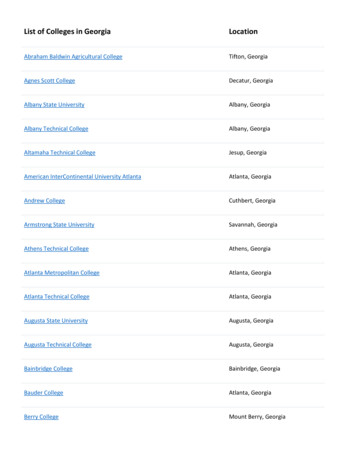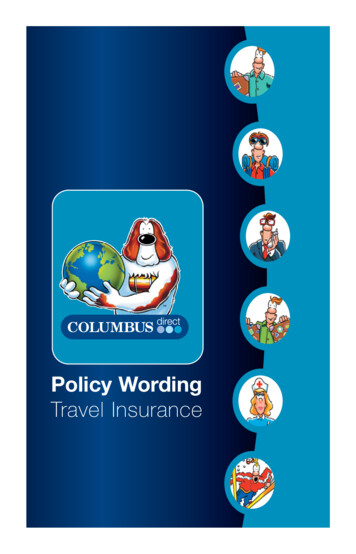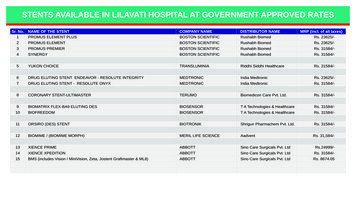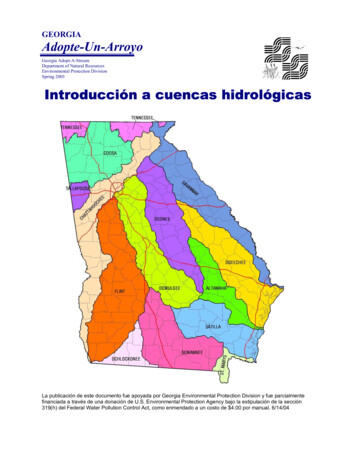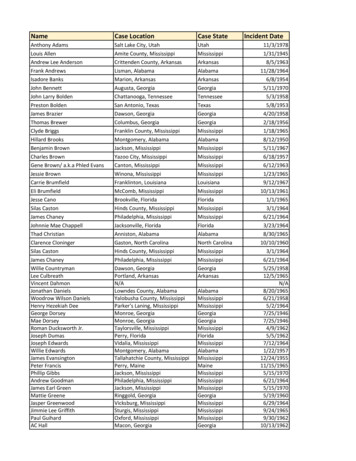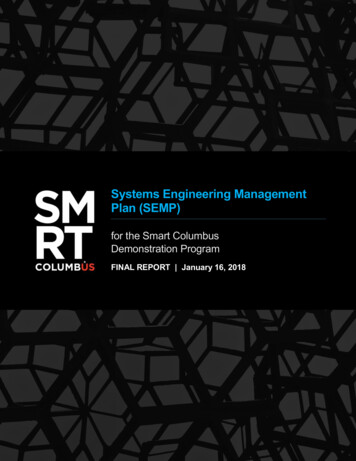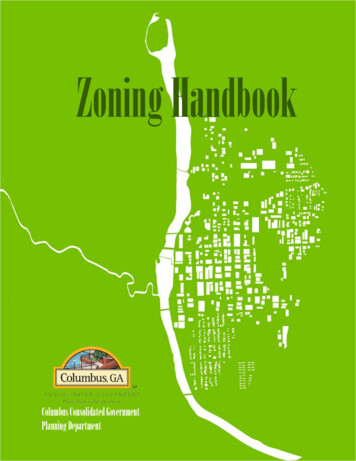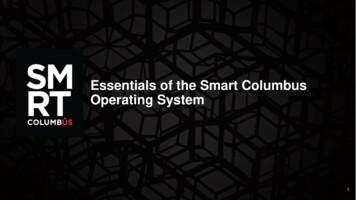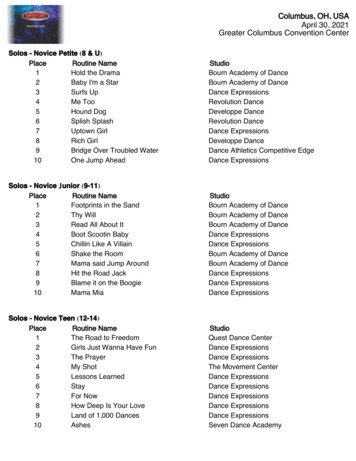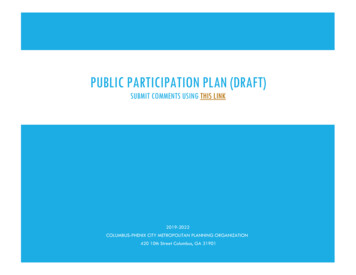
Transcription
1PUBLIC PARTICIPATION PLAN (DRAFT)SUBMIT COMMENTS USING THIS LINK2019-2022COLUMBUS-PHENIX CITY METROPOLITAN PLANNING ORGANIZATION420 10th Street Columbus, GA 31901
2DRAFT (submit comments to cpcmpo@columbusga.org or at this link.) The 45-day comment period is open from June 19 to August 3, 2018.We Invite Youto Join Us in Shapingthe Future of Mobilityfor the Columbus-Phenix CityMetro Region.[Welcome Messages][From Chair of the Policy Committee][From Chair of the Citizen Advisory Committee]
3DRAFT (submit comments to cpcmpo@columbusga.org or at this link.) The 45-day comment period is open from June 19 to August 3, 2018.COLUMBUS-PHENIX CITYMETROPOLITAN PLANNING ORGANIZATION (MPO)DRAFT PUBLIC PARTICIPATION PLAN 2019-2022View this document at http://www.columbusga.org/PlanningFor Information regarding this document, please contactCarolina Rodriguez, Transportation PlannerColumbus-Phenix City Transportation Study420 10th Street, 2nd FloorP.O. Box 1340Columbus, Georgia 31902Telephone: 706-225-3920FAX: 706-653-4534Email: rodriguez.carolina@columbusga.orgDate adopted TBDThe Public Participation Plan was prepared as a cooperative effort of the U.S. Department of Transportation, Federal Highway Administration,Federal Transit Administration, the Alabama Department of Transportation, the Georgia Department of Transportation, and local participatinggovernments, in partial fulfillment of requirements in Title 23 USC 134 and 135, amended by the FAST Act, Sections 1201 and 1202, December2015. The contents of this document do not necessarily reflect the official views or policy of the U.S. Department of Transportation.The Columbus-Phenix City MPO complies with Title VI of the Civil Rights Act of 1964 (42 U.S.C. 2000d et seq.), which states that “no person in theUnited States shall, on the ground of race, color, or national origin, be excluded from participation in, be denied the benefits of, or be subjected todiscrimination under any program or activity receiving Federal financial assistance.” In addition to Title VI, there are other Nondiscrimination statutesthat afford legal protection. These statutes include the following: Section 162 (a) of the Federal-Aid Highway Act of 1973 (23 USC 324) (sex),Age Discrimination Act of 1975 (age), and Section 504 of the Rehabilitation Act of 1973/Americans with Disabilities Act of 1990 (disability).
4DRAFT (submit comments to cpcmpo@columbusga.org or at this link.) The 45-day comment period is open from June 19 to August 3, 2018.Page reserved for Resolution
5DRAFT (submit comments to cpcmpo@columbusga.org or at this link.) The 45-day comment period is open from June 19 to August 3, 2018.ContentsABOUT THE MPO. 6What is the Columbus-Phenix City MPO? . 6What does the MPO do? . 6Did You Know ? . 6Transportation Planning Process. 7CPCMPO Planning Activities . 8Committee Structure. 9PUBLIC INVOLVEMENT PLAN . 10Why Should You Be Involved?. 10How do Transportation Decisions Affect People and Communities? . 10Civil Rights Policy Framework . 11Spectrum of Public Participation . 12Performance Measures . 13. 13PUBLIC PARTICIPATION TOOLS . 14Calendar of Prioritized Community Events . 14Community Characteristics Interactive Map . 15Additional Location-based Tools. 15Experiential Techniques. 16Partnering with Community-Based Organizations . 16HOW ARE WE DOING?. 17After Action Report . 17Public Involvement Evaluation Report (PIER) . 18LEARN MORE . 19
6DRAFT (submit comments to cpcmpo@columbusga.org or at this link.) The 45-day comment period is open from June 19 to August 3, 2018.ABOUT THE MPOWhat is the Columbus-Phenix City MPO?The Columbus-Phenix City Metropolitan Planning Organization (MPO) is your region’s public decision-making policyboard for prioritizing spending of federal, state, and local multimodal transportation dollars. CPCMPO is hosted bythe Columbus Consolidated Government’s Planning Department.What does the MPO do?The core functions of the MPO are to—1) Establish and manage a fair and impartial setting for effective regional decision making.2) Use data and planning methods to identify and evaluate transportation improvement options.3) Develop long- and short- range plans, programs, and studies to address the region’s multimodal needs.4) Involve the public in all stages of transportation planning and programming.Did You Know ?The Columbus-Phenix City MPO, one of the first in thenation, was established in 19641. The planning areaincludes— 734 square miles 280,000 people (about 380 persons/sq.mi.) 2 State Departments of Transportation 5 Counties 2 Cities 2 Transit Providers 1 airport 6 staff members1For a complete listing of MPOs across the country, visit https://www.planning.dot.gov/mpo.asp.
7DRAFT (submit comments to cpcmpo@columbusga.org or at this link.) The 45-day comment period is open from June 19 to August 3, 2018.Transportation Planning ProcessThe transportation system includes everything from roadways, stormwater infrastructure, and transit to rail, air,bicycle, and pedestrian facilities. How the system performs influences many aspects of everyday life likeemployment, housing, air quality, social equity, safety, sense of place, and environmental conservation. As you cansee from Figures 1 and 2, transportation planning connects investments to broader regional goals. MPOs arerequired to use a performance-based process to show how investments lead to desired community outcomes.Figure 2. Transportation Planning Process. CPCMPO develops a long-range plan called theMetropolitan Transportation Plan (MTP).Figure 1. Framework for Performance-Based Planning and Programming. Performancemeasures indicate how ell the transportation system meets agency and public goals andexpectations.
8DRAFT (submit comments to cpcmpo@columbusga.org or at this link.) The 45-day comment period is open from June 19 to August 3, 2018.CPCMPO Planning ActivitiesThe Columbus-Phenix City Metropolitan Planning Organization is responsible for updating and monitoring thefollowing planning activities and products. Click on the title to view the latest version of the document.Planning ActivityMetropolitan TransportationPlan (MTP)Formerly called the Long RangeTransportation Plan (LRTP)Transportation ImprovementProgram (TIP)Unified Planning WorkProgram (UPWP)Public Participation Plan (PPP)Congestion Management Plan(CMP)Special Studies2DescriptionLong range plan with a 20-year planning horizon.Uses performance measures and targets.Policies and actions lead to a regional and multimodal transportation network.Mobility and access for peoples and goods.Promotes the preservation and efficient performance of existing system; good quality of life.Fiscally constrained guide for project selection.Updated every 5 years and amended as needed.Based on the MTP.Short range program with a 4-year timeframe.Capital and non-capital surface transportation, bicycle and pedestrian facilities, and transit.Financial plan is detailed.Agency responsible for implementation is listed.Describes how projects will work towards achieving performance measures.Updated every 4 years and amended as needed.Detailed list of urban transportation planning studies and tasks during the fiscal year.Guides staff work for the MPO.Identifies funding, personnel, and timeline for planning.Updated every fiscal year2.Action plan for engaging the public including traditionally underserved communities.All planning activities must be done in collaboration with the public.Evaluated yearly and updated as needed.Required for Transportation Management Areas (TMA) with population 200,000.Strategies for reducing congestion and increasing mobility.Used to study investment options.Studies can focus on corridors, a specific mode, or policy issue.The fiscal year for State of Georgia and Columbus Consolidated Government is 1 July to 30 June.
9DRAFT (submit comments to cpcmpo@columbusga.org or at this link.) The 45-day comment period is open from June 19 to August 3, 2018.Committee StructurePolicy CommitteeMeets3rdTuesday. Reviews and approves all studies, plans, and programs. Ensures public involvement.Obtains optimum cooperation. Designates members to the technical and citizen committees.Mayor Teresa Tomlinson, Columbus, ChairMayor Eddie Lowe, Phenix City, Vice ChairSuzanne Burnette, Lee Russell COG, PEXDennis Caliyo, Chairman, Citizens Advisory CommitteeGerald Douglas, Chairman, Cusseta-Chatt. CommissionBill English, Chairman, Lee County CommissionRosa Evans, Director of METRA, ColumbusSteve Graben, Southeast Regional Engineer, Alabama DOTRick Jones, Director of Planning, ColumbusPeggy Martin, Chairman, Russell County CommissionRussell McMurry, Commissioner, Georgia DOTSam Wellborn, Georgia State Transportation BoardRodney N. Barry, P.E. Division Administrator, FHWA, GA (non-voting)Mark D. Bartlett, Division Administrator, FHWA, AL (non-voting)Ed Phillips, Jr. PE, State Local Transportation Engineer, ALDOT (nonvoting)Michael Presley, District Engineer, GDOT (non-voting)Radney Simpson, Office of Planning, GDOT (non-voting)Technical CommitteeMeets Thursday of 2nd Full Week. Reviews studies, plans, and programs and makes recommendations to the policy committee.Maintains data inventories to inform planning process. Prepares an annual report on status of transportation.Rick Jones, Director of Planning, Columbus, ChairJim Adcock, Master Planner, Fort BenningRamsey Ashmore, Montgomery Area Traffic Engineer, Alabama DOTTom Bickel, Board of Commissioners, Chattahoochee CountyShawn Blakeney, Russell County EngineerPatti Cullen, Executive Director, River Valley Regional CommissionVacant, Traffic Engineer, ColumbusFelton Grant, Transportation Planning Coordinator, ColumbusJustin Hardee, Lee County EngineerPam Hodge, Deputy City Manager, ColumbusRichard Howell, Director, Columbus AirportWallace Hunter, City Manager, Phenix CityMatt Leverette, Division Pre-Construction Engineer, Alabama DOTAngel Moore, City Engineer, Phenix CityAdam Smith, Pre-Construction Engineer, GDOTJeremy Whittlesey, METRA, ColumbusJacqueline R. Williams, Transportation Planning Specialist, GeorgiaDOTClint Andrews, Federal Highway Administration, Alabama (nonvoting)Vance Beck, District Manager, SE Region Montgomery Area, ALDOT(non-voting)Suzanne Burnette, Lee-Russell Council of Governments (non-voting)Carol Comer, Multi-modal Planning Division, Georgia DOT (nonvoting)Andrew Edwards, Planning Team Leader, and FHWA, Georgia (nonvoting)Michael Hora, PE, Asst. State Local Transportation Engineer,Planning, ALDOT (non-voting)Dennis Caliyo, Chairman, Citizens Advisory Committee (non-voting)Olivia Lewis, Federal Highway Administration, Georgia ((non-voting)Harland Smith, District Planning & Programming Coordinator, GDOT(non-voting)Tim Toomy, Area Engineer, GDOT, (non-voting)Citizens Advisory CommitteeMeets 3pm Tuesday of 2nd Full Week. Provides general advice concerning public views.Reviews and participates in work elements. Communicates with public.Dennis Caliyo, Columbus – ChairJonnell Carol Minefee, Columbus – Vice ChairOree Crittendon, ColumbusSally Bork Lasseter, ColumbusDaisy Lynton, Russell County, AlabamaPatrick McHenry, ColumbusAnnie C. Mazyck, ColumbusJim Pound, ColumbusMike See – ColumbusAlfred Stewart, ColumbusRick Jones, Director of Planning, Secretary (non-voting)Herbert Hill, Muscogee County School District (non-voting)Steve Vaughn, Civil Engineer Operations & Maintenance, FortBenning (non-voting)Steven Dewitt, METRA (non-voting)Vincent Crosse, Chairman, Phenix City Chamber of Commerce (nonvoting)
10DRAFT (submit comments to cpcmpo@columbusga.org or at this link.) The 45-day comment period is open from June 19 to August 3, 2018.PUBLIC INVOLVEMENT PLANWhy Should You Be Involved?While state & local departments of transportation and transit agencies sponsor and implement projects, the MPOdetermines how funds are invested in your region. It was not always the case that the transportation system workedfor everyone. Today’s MPO leaders and stakeholders value the opportunity to engage with you on transportationissues that affect you and your community.How do Transportation Decisions Affect People and Communities?MPOs are required to consider projects and strategies that— Support the economic vitality of the metropolitan area, especially by enabling global competitiveness,productivity, and efficiency. Increase the safety of the transportation system for motorized and non-motorized users. Increase the security of the transportation system for motorized and non-motorized users. Increase the accessibility and mobility of people and for freight. Protect and enhance the environment, promote energy conservation, improve the quality of life, and promoteconsistency between transportation improvements and State and local planned growth and economicdevelopment patterns. Enhance the integration and connectivity of the transportation system, across and between modes, for peopleand freight. Promote efficient system management and operation. Emphasize the preservation of the existing transportation system. Improve the resiliency and reliability of the transportation system and reduce or mitigate stormwater impactsof surface transportation. Enhance travel and tourism.
11DRAFT (submit comments to cpcmpo@columbusga.org or at this link.) The 45-day comment period is open from June 19 to August 3, 2018.Civil Rights Policy FrameworkThrough early and continuous public engagement, MPO decisions are accountable to the public. As an agencyrepresenting federal, state, and local interests, MPOs and participating agencies must uphold a variety of laws,statutes, and executive orders3.Americans withDisabilities Act (ADA)Title VI Program4How does itrelate totransportation? Ensure pedestrians with disabilitieshave opportunity to use thetransportation system in anaccessible and safe manner. Who must follow? State and local governmentsAll public organizations What areagenciesrequired toprovide? Where can youget involved? Accessible buildings, buses, trains,sidewalks, and more.When agencies providetransportation options, they mustbe accessible for persons withdisabilities.Public meetings for new projects.State or local disability councilsFile a complaint with a local, state,or federal agency if something isnot accessible. Environmental Justice5(EJ)FHWA Title VI Program is broaderthan the statute and encompassesrace, color, national origin, sex, age,limited English proficiency, lowincome, and disability.State and local governments thatreceive federal grants and aid.Governmental organizations.Title VI Plan.Notice to the public.Translation/interpreters for peoplewith limited English proficiency. Public meetings when governmentorganizations do transportationplanning.Public meetings during the NEPAprocess.File a complaint with a local, state,or federal agency if you feel aproject discriminates. Data collection andanalysis; Assess adverseimpacts on minorityand/or low-incomepopulations.Federal agenciesMeaningful publicparticipation.Adopt USDOT EJPrinciples.Public meetings forprojects affecting yourcommunity.FHWA and FTA provide additional resources via the Office of Civil Rights. This chart is adapted from 2017 Update of Transportation Briefing Book.To learn more about Title VI, visit df.5 To learn more about Environmental Justice, visit https://www.columbusga.gov/planning/enviro justice.htm.34
12DRAFT (submit comments to cpcmpo@columbusga.org or at this link.) The 45-day comment period is open from June 19 to August 3, 2018.Spectrum of Public ParticipationThe International Association for Public Participation places efforts to engage the public along a spectrum 6 reflecting increasing impacton decision-making. CPCMPO decisions range from informal to formal and are made by high level authorities as well as MPO staff.We strive to obtain the right level of participation depending on the type of decision being made. Below are examples of how weengage the public along this continuum. Information isavailable in theoffice and online.Public notices andpress releases.Map oftransportationprojects.Facebook events Public hearing priorto the adoption ofplans.Response to publicinput and inquiries.Incorporation offeedback into plans.Anyone can proposea transportationproject. 6Stakeholders areinvolved indevelopingalternatives.Projects prioritizedusing public’s input.Public’s goals arereflected in plans.Dialogue with publicon policy issues.Experientiallearning. Community membersserve on the CitizenAdvisory Committeeand engage thepublic ontransportation policyissues.Advise the PolicyCommittee; .org/resource/resmgr/foundations course/IAP2 P2 Spectrum FINAL.pdf Citizen AdvisoryChairperson sits onthe PolicyCommittee.Has 1 vote.
13DRAFT (submit comments to cpcmpo@columbusga.org or at this link.) The 45-day comment period is open from June 19 to August 3, 2018.Performance MeasuresOur Goal is to Deliver an Excellent Public Involvement Process Responsive to the Needs of the Community and Decision-makers7.Provide EquitableAccess to TransportationDecision-Making.Continuously Engagethe Public onTransportation Issues.7 1.1 Meetings are held at convenient and accessible locations and times. 1.2 Visualization techniques are employed to describe plans. 1.3 Information is available online and in electronically accessible formats. 1.4 CPCMPO products are published to allow for a 30-45 day comment period. 1.5 Information, in languages other than English, is provided where needed. 2.1 Community Characteristics Interactive Map is published and updated annually. 2.2 Calendar of prioritized community events is published quarterly . 2.3 Experiential techniques are used to engage the community on policy issues. 2.4 Citizens Advisory Committee actively engages the community on policy issues.Reach CommunitiesUnderserved byTransportation Planning. 3.1 CPMPO pursues initiatives that reach beyond the usual stakeholders and interestgroups. 3.2 CPCMPO leverages relationships with organizations working with communitiesand users identified as underserved by transportation planning. 3.3 List of community-based organizations for targeted outreach and partnership ispublished quarterly.Evaluate and ImprovePublic ParticipationEfforts and Outcomes. 4.1 After Action Report is completed no later than 2 weeks after outreach activities. 4.2 After Action Reports include questions to measure implementation ofpublicparticipation performance measures. 4.3 Public Involvement Evaluation Report is published annually to aid in evaluation.CPCMPO achieves desired outcomes by balancing the development of required planning products and the available resources of funds and staff time.
14DRAFT (submit comments to cpcmpo@columbusga.org or at this link.) The 45-day comment period is open from June 19 to August 3, 2018.PUBLIC PARTICIPATION TOOLSCalendar of Prioritized Community EventsMonthEventPolicy OpportunityJanuaryMLK CelebrationEquity, Environmental Justice, Title VIFebruaryBlack History Month ProgramsArbor Day ProgramsHeart Health MonthEquity, Environmental Justice, Title VIAir Quality, Climate Change, EnvironmentLand Use, Health, Equity, AgingMarchSafe Routes to SchoolLiteracy Alliance ProgramsSafety, Equity, Land Use, Congestion ManagementEquity, limited English proficiencyAprilCreative SouthRecycling Center Earth DayJane’s WalkNational Bike MonthCommunity Bike RideFort Benning Fourth of JulyBack to SchoolHispanic Heritage FestivalCSU Health ConferenceUptown SpooktacularWay Down Film FestivalCommunity Bike RideOn the TableEquity, YouthAir Quality, Climate Change, Environment, Land UseEquity, Land UseSafety, Equity, Land Use, Congestion ManagementEquity, Congestion Management, SafetyEquity, Military, Safety, CongestionSafety, Children, Land UseEquity, limited English proficiencyEquity, Youth, Environmental JusticeEquity, ChildrenEquity, YouthEquity, Environmental Justice, Title VILand Use, EquityNovemberNational Planning MonthLet’s Grow STEAMLand Use, EquityEquity, ChildrenDecemberSafe Kids Helmet GiveawayMr. Jackson’s Bike GiveawaySafety, Equity, Environmental Justice, Title VIEquity, Environmental Justice, Title VIMayJuneJulyAugustSeptemberOctoberInvite MPO staff to attend your community event by emailing cpcmpo@columbusga.org.
15DRAFT (submit comments to cpcmpo@columbusga.org or at this link.) The 45-day comment period is open from June 19 to August 3, 2018.Community Characteristics Interactive MapTransportation Planning recognizes the adverse impacts of transportation projects of the past on communities whodid not have a voice in previous decision-making processes. To engage the public, we first identify who we need toreach. We analyze the geographic distribution of various indicators to identify underserved communities in theCPCMPO area at the Census tract level. Staff combines indicators to understand which areas demonstrate anelevated presence of indicators. An overlay of transportation facilities and services assists the MPO in tailoringpublic involvement based on benefits and burdens. The map will be updated annually to coincide with the annualrelease of American Community Survey (ACS) datasets. The goal is to continue to develop the analysis into a robustcommunity characteristics inventory. The following are the indicators we propose including in the initial analysis.Population & EmploymentAge8Transportation MeansMinorityPopulationChildren 5-14Commute by Walking,Non-Hispanic MinorityHouseholdsYouth 15-24Bicycling, and TransitHispanic/Latino OriginDensitySeniors 75 No vehicle in householdsFemale Head of HouseholdWhere are the jobsWhere workers liveUS Census Sources: Decennial, ACS 5-year estimates (2012-2016), On The Map 2015AbilityLow income and povertyPersons with disabilitiesLimited English SpeakingRenter occupiedAdditional Location-based ToolsCenter for Neighborhood Technology (CNT)The Housing and Transportation (H T) Affordability Index combines the costs of housing and transportation showinga more realistic measure of affordability. The data can be viewed from the Census block level to the Metro region.Response Outreach Area Mapper (ROAM)This Census tool uses a low response score to identify hard-to-survey populations. The information is used to tailorcommunication, partner with community-based organizations, and adjust field practices. CPCMPO values using thisresource for the similar purpose of public engagement.8Research shows that these age groups have non-automobile travel demands often unmet in auto-centric decision-making.
16Experiential TechniquesAn effective public involvement program continually brings the public along on transportation matters. CPCMPOhelps the public learn about transportation policy issues by using a variety of techniques and strategies. Experientialor participatory learning is particularly effective9. CPCMPO will incorporate the following techniques into publicparticipation efforts. Demonstration and Pop up projectsSimulationScenario testingInteractive mapsHigh Quality SurveysCharrettes and visioningWalking audits and toursBike RidesTransit experiencesVoting and prioritizing activitiesMaker activitiesTell me, and I forget.Teach me, and I remember.Involve Me, and I Learn.Partnering with Community-Based OrganizationsCommunity based organizations are formed by and for people in a community to advance their shared interestsand local level concerns10. CPCMPO staff will attend regularly scheduled meetings to present relevanttransportation information and gather input. Staff will work with CPCMPO Committee members to publish aquarterly schedule of community-based organization opportunities for targeted outreach.Incorporating Qualitative Data in the Planning Process: Improving Project Delivery and Outcomes. Federal Highway Administration, March 2017.https://www.fhwa.dot.gov/environment/bicycle pedestrian/publications/qualitative data/fhwahep17075.pdf10 FHWA describes how MPOs can improve planning capacity by partnering with Community-Based nvolvement/pi documents/1b-a.asp9
17DRAFT (submit comments to cpcmpo@columbusga.org or at this link.) The 45-day comment period is open from June 19 to August 3, 2018.HOW ARE WE DOING?After Action ReportIn order to evaluate the outcomes of public participation efforts by CPCMPO, staff records activities using an AfterAction Report (AAR). We use a Google Form; an efficient and collaborative tool for collecting and analyzingresponses. Questions on the AAR measure public participation performance objectives11. Click here to view the AAR.QUESTION # RESPONSE )19(4)19(5)Email address of responderDateStart TimeEnd TimeLocationStaff or Committee members who worked the event/activity?How did MPO notify participants?If applicable, list publication dates of public notices for this meeting/event.W
The Columbus-Phenix City MPO complies with Title VI of the Civil Rights Act of 1964 (42 U.S.C. 2000d et seq.), which states that "no person in the United States shall, on the ground of race, color, or national origin, be excluded from participation in, be denied the benefits of, or be subjected to
